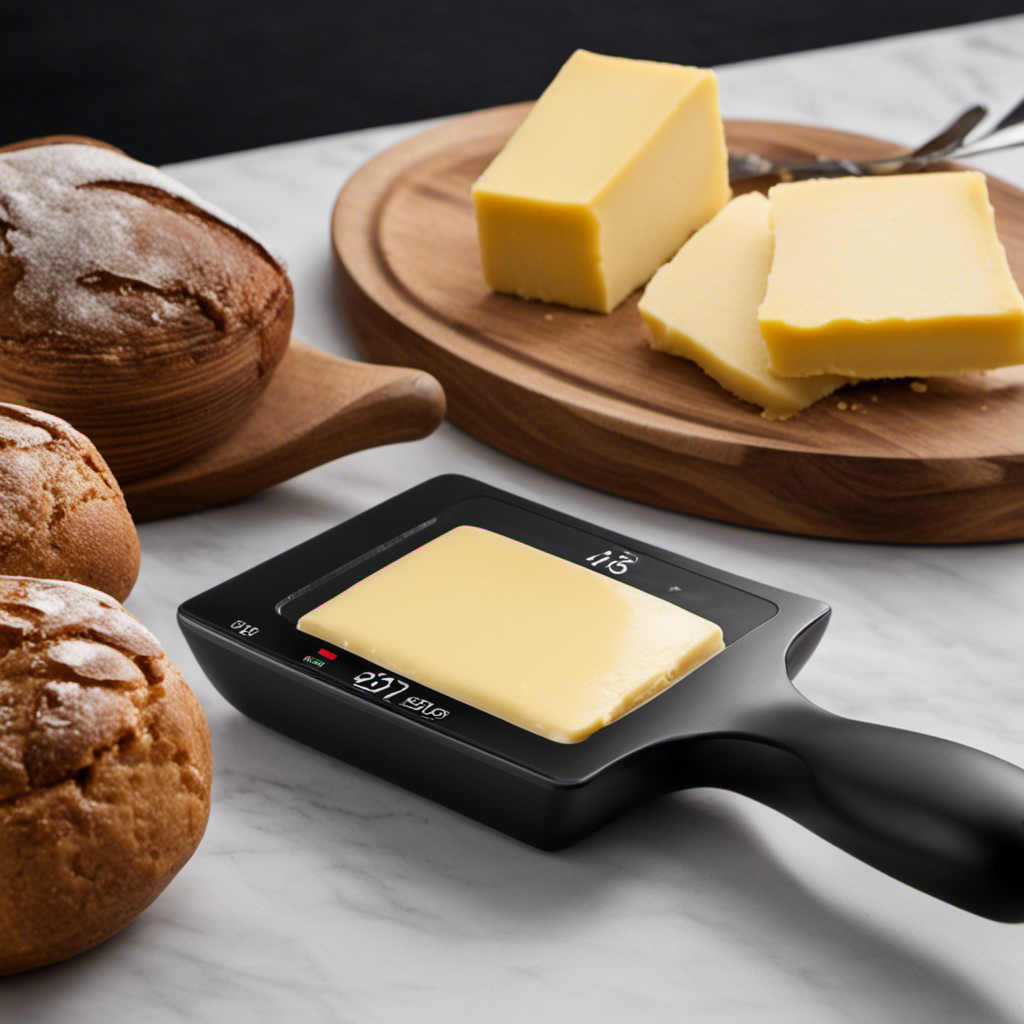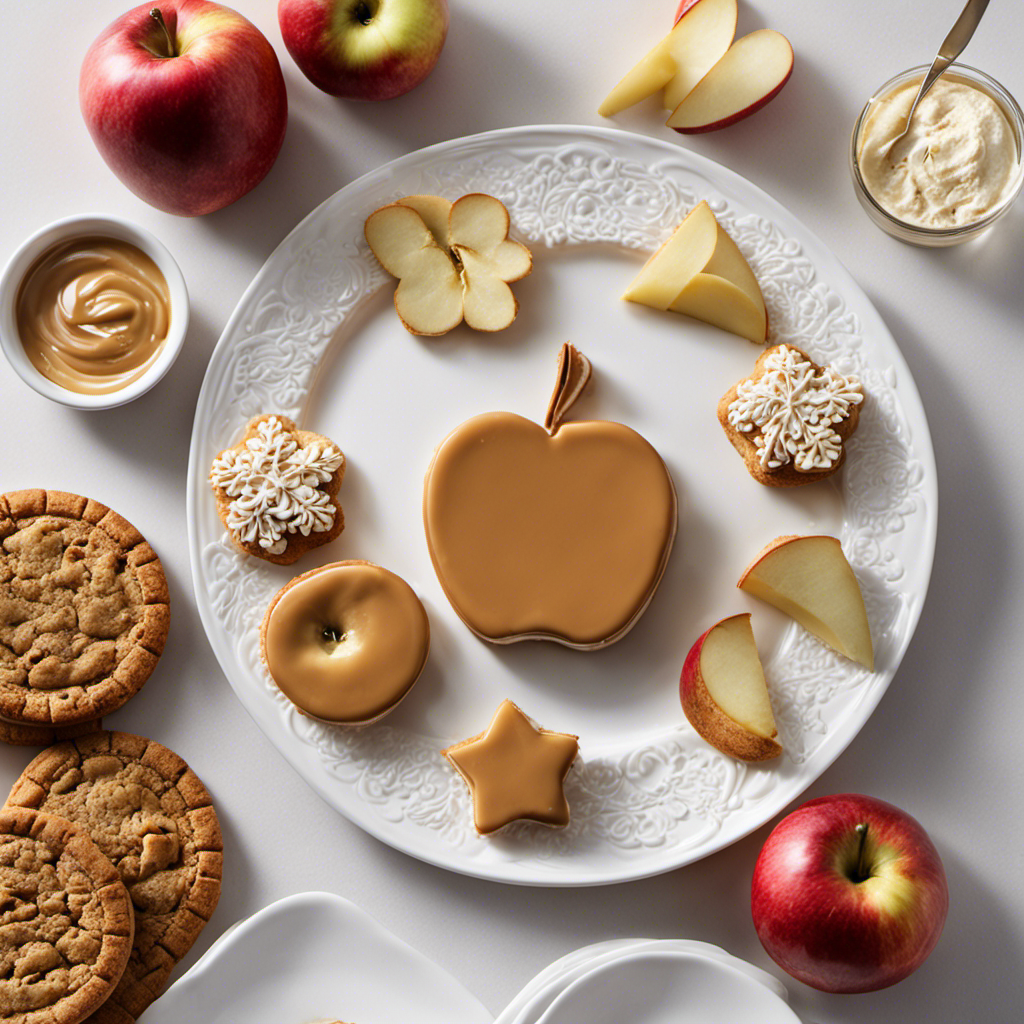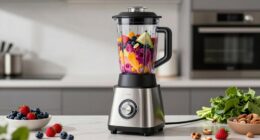As a kitchen enthusiast who enjoys trying out new flavors, I was excited to learn about the many ways to savor apple butter. Were you aware that every year, more than 200 million pounds of apples are converted into this tasty spread?
From spreading it on warm toast to incorporating it into baked goods, the possibilities are endless. In this article, I will share some creative and mouthwatering ideas on what to do with apple butter.
Get ready to elevate your meals and satisfy your taste buds!
Key Takeaways
- Apple butter can be used as a spread or topping for breakfast foods like toast, bagels, and pancakes.
- It can be incorporated into various breakfast dishes such as waffles, crepes, and oatmeal to add flavor.
- Apple butter is versatile and can be used in meal prep, including adding it to yogurt or using it as a glaze for roasted meats.
- It can also be used in baked goods, mixed with cream cheese for a dip, or drizzled over roasted vegetables to add sweetness.
Spread It on Toast or Bagels
You should spread it on your toast or bagels to enjoy the deliciousness of apple butter.
Apple butter is a versatile condiment that can enhance your breakfast spreads and add a burst of flavor to your morning routine. The smooth and velvety texture of apple butter spreads effortlessly onto your favorite bread, creating a delectable combination of sweet and tangy flavors.
Whether you prefer a simple slice of toast or a hearty bagel, apple butter adds a unique twist to your morning meal. It’s not just limited to breakfast either; apple butter makes for creative sandwich toppings as well. The rich, caramel-like taste pairs perfectly with both sweet and savory ingredients, making it a delightful addition to any sandwich.
Use It as a Topping for Pancakes or Waffles
To make your breakfast even more delicious, spread some of that apple butter on top of your pancakes or waffles. The rich, velvety texture of the apple butter adds a burst of flavor that perfectly complements the fluffy goodness of the pancakes or the crispy edges of the waffles.
But don’t stop there! Get creative with your apple butter and use it as a filling for pancakes or crepes. Imagine biting into a warm, fluffy pancake with a sweet and tangy apple butter filling oozing out. It’s pure bliss.
And if you’re feeling indulgent, drizzle some of that apple butter over a scoop of vanilla ice cream or frozen yogurt. The combination of the creamy, cold dessert with the warm, spiced apple butter is simply heavenly.
Mix It Into Oatmeal or Yogurt
When it comes to breakfast, I’m always looking for ways to enhance the flavors and make my meals more exciting.
One of my favorite ways to do this is by mixing apple butter into my oatmeal or yogurt. The sweet and tangy flavor of the apple butter adds a burst of deliciousness to every bite, making my breakfasts feel like a special treat.
Plus, the versatility of apple butter allows me to get creative with my meal prep, whether I’m adding it to overnight oats or layering it in a parfait.
Enhancing Breakfast Flavors
Adding apple butter to your morning toast or pancakes can really elevate the flavors and make breakfast more delicious. Here are a few breakfast recipe ideas and flavor pairing suggestions to make the most of your apple butter:
-
Apple Butter French Toast: Dip thick slices of bread in a mixture of beaten eggs, milk, and a spoonful of apple butter. Cook until golden brown and top with a dollop of apple butter for a sweet and tangy twist.
-
Apple Butter Smoothie Bowl: Blend frozen banana, yogurt, and a spoonful of apple butter for a creamy and nutritious breakfast. Top with granola, sliced apples, and a drizzle of apple butter for added crunch and flavor.
-
Apple Butter Pancakes: Stir apple butter into your pancake batter for a burst of apple flavor. Serve with a generous spread of apple butter and a sprinkle of cinnamon for a cozy and comforting breakfast treat.
-
Apple Butter Breakfast Parfait: Layer Greek yogurt, granola, and diced apples in a glass. Drizzle each layer with apple butter for a sweet and satisfying breakfast parfait.
With these breakfast ideas and flavor pairings, you can truly transform your morning meal into a delicious apple-infused delight.
Versatility in Meal Prep
One way you can really maximize your meal prep is by exploring the versatility of different ingredients. Take apple butter, for example. This delicious spread can be used in a variety of ways to enhance the flavors of your meals.
Not only can you enjoy it on toast or pancakes, but you can also incorporate it into savory dishes. For instance, adding a spoonful of apple butter to soups can add a hint of sweetness and depth of flavor. It can also be used as a glaze for roasted meats or as a marinade for grilled chicken.
Additionally, apple butter can be a great addition to stir-fries, providing a unique twist to the dish. It adds a touch of sweetness and helps balance out the flavors.
Incorporate It Into Baked Goods Like Muffins or Cookies
When it comes to food, I love exploring different flavor combinations that can take a dish to the next level.
One of my favorite things to experiment with is sweet and savory pairings. There’s something magical about the way contrasting flavors can come together to create a truly unique and delicious experience.
Whether it’s adding a touch of honey to a savory dish or pairing chocolate with salty ingredients, these unexpected combinations can elevate any meal to new heights.
Sweet and Savory Pairings
To enhance the flavors of apple butter, it’s great to experiment with sweet and savory pairings. Here are some creative ways to use apple butter in unique flavor combinations:
- Spread it on a grilled cheese sandwich for a delightful mix of sweet and savory.
- Mix it with cream cheese to create a delicious and versatile dip for crackers or fresh fruit.
- Drizzle it over roasted vegetables, like Brussels sprouts or sweet potatoes, to add a touch of sweetness.
- Use it as a glaze for meats, such as pork chops or chicken, to add a burst of flavor.
These sweet and savory flavor combinations not only enhance the taste of apple butter, but they also add a new dimension to your dishes.
Now, let’s explore some other unique flavor combinations using apple butter.
Unique Flavor Combinations
If you’re looking for unique flavor combinations, try adding apple butter to a spicy chili or a tangy barbecue sauce for a delicious twist. The sweet and tangy flavor of apple butter adds a depth of flavor that enhances the richness of these savory dishes.
But did you know that apple butter can also be used to enhance cocktails and pair with cheese? Imagine a refreshing apple butter margarita, where the sweetness of the apple butter balances out the tartness of the lime juice. Or how about a cheese board with a dollop of apple butter alongside a sharp cheddar or creamy brie? The combination of the sweet apple butter and the savory cheese creates a mouthwatering contrast that is sure to impress your guests.
Speaking of sweet treats, let’s dive into the next section and learn how to make apple butter swirl ice cream!
Make Apple Butter Swirl Ice Cream
Let’s start by making the apple butter swirl for the ice cream. It’s a delicious addition that adds a burst of flavor to every creamy bite.
Here’s how you can make it:
-
Begin by whisking together apple butter, sugar, and a splash of lemon juice in a small saucepan over medium heat. Cook the mixture until it thickens slightly and the flavors meld together, stirring occasionally.
-
Once the apple butter mixture is ready, let it cool completely before swirling it into your homemade ice cream base.
-
Gently fold the apple butter swirl into the ice cream mixture, making sure not to overmix.
The result is a delectable treat that combines the rich creaminess of ice cream with the sweet and tangy flavors of apple butter. It’s perfect on its own or as a topping for apple butter cocktails or apple butter bread pudding.
Use It as a Filling for Crepes or Turnovers
After indulging in a bowl of homemade Apple Butter Swirl Ice Cream, my mind started to wander about other creative uses for this delectable spread.
One idea that immediately came to mind was using apple butter as a filling for pastries like crepes or turnovers. Imagine biting into a warm, flaky pastry and being greeted with a burst of sweet and tangy apple goodness.
The creamy texture of the apple butter would perfectly complement the delicate pastry, creating a mouthwatering combination. Whether you’re hosting a brunch or simply looking for a delicious treat, using apple butter as a filling for pastries is a surefire way to impress your guests and satisfy your cravings.
Add It to a Cheese or Charcuterie Board
When it comes to creating the perfect cheese pairing, I love exploring the delightful combination of savory and sweet flavors. There’s something truly magical about the way a savory cheese can be elevated by the addition of a sweet accompaniment.
Whether it’s a tangy blue cheese with a drizzle of honey or a creamy brie with a dollop of fig jam, these combinations never fail to excite the taste buds and create a truly memorable culinary experience.
Join me as we dive into the world of perfect cheese pairings and discover the endless possibilities of this savory and sweet combo.
Perfect Cheese Pairing
The perfect cheese pairing for apple butter is a creamy brie. This combination creates a delightful balance of flavors that enhances breakfast dishes. Here’s why it’s the perfect choice:
-
Creamy Texture: The smooth and creamy texture of brie complements the velvety consistency of apple butter, creating a luxurious mouthfeel.
-
Sweet and Savory: The sweet and tangy notes of apple butter beautifully contrast with the rich and slightly salty taste of brie, making each bite a delightful experience.
-
Toasted Bread: Pairing brie and apple butter with a slice of toasted bread adds a subtle crunch that enhances the overall flavors and creates a satisfying breakfast option.
-
Versatility: Brie can be enjoyed on its own or combined with other ingredients like nuts or dried fruits, allowing you to experiment and create your own unique flavor combinations.
Savory and Sweet Combo
Now that we’ve explored the perfect cheese pairing for apple butter, let’s delve into the exciting world of sweet and savory flavor combinations.
Apple butter’s versatility extends beyond the realm of spreads and condiments. It can be used in innovative culinary ways to create mouthwatering dishes that balance the sweetness of the apple with savory ingredients.
One delightful example is using apple butter as a glaze for roasted meats like pork or chicken. The natural sweetness of the apple butter caramelizes beautifully, creating a sticky and savory crust that adds depth to the dish.
Another inventive use is incorporating apple butter into marinades or dressings, adding a tangy sweetness that complements vegetables like Brussels sprouts or kale.
Don’t limit your creativity when it comes to apple butter. Explore the possibilities and let it inspire you to create unique and delicious flavor combinations that will tantalize your taste buds.
Make a Savory Glaze for Roasted Meats or Vegetables
To make a savory glaze for roasted meats or vegetables, you can combine apple butter with Dijon mustard, soy sauce, and garlic. This unexpected combination of ingredients creates a deliciously unique flavor profile that will elevate your dishes to a whole new level.
Here are four reasons why you should try using apple butter as a savory glaze alternative:
-
Sweet and tangy: The natural sweetness of apple butter pairs perfectly with the tanginess of Dijon mustard, creating a well-balanced flavor that will enhance the taste of your roasted meats or vegetables.
-
Umami richness: The addition of soy sauce adds depth and richness to the glaze, giving your dishes a savory and umami-packed punch.
-
Aromatic garlic: The minced garlic adds a fragrant and pungent note to the glaze, enhancing the overall flavor and adding complexity to your roasted meats or vegetables.
-
Versatility: This savory glaze is incredibly versatile and can be used on a variety of meats and vegetables. From roasted chicken to grilled vegetables, the possibilities are endless.
Mix It Into a Salad Dressing or Vinaigrette
You can elevate your salads by mixing apple butter glaze into your dressing or vinaigrette for a unique burst of flavor. The rich and sweet taste of apple butter adds depth and complexity to your usual salad dressing.
Simply whisk together your favorite dressing ingredients, like olive oil, vinegar, mustard, and a spoonful of apple butter glaze. The result is a tangy, slightly sweet dressing that pairs perfectly with fresh greens, fruits, and nuts.
Not only does it add a delicious twist to your salads, but apple butter glaze can also be used as a marinade for grilled chicken or pork. The natural sweetness of the glaze caramelizes beautifully on the grill, creating a mouthwatering crust on the meat.
Use It as a Base for a Barbecue Sauce or Marinade
Mixing apple butter glaze into your barbecue sauce or marinade adds a rich and sweet flavor that will take your grilled dishes to the next level. Here are four reasons why you should try incorporating apple butter into your barbecue sauce or marinade:
-
Enhanced flavor: The natural sweetness of apple butter complements the smoky and tangy flavors of barbecue sauce, creating a perfect balance of taste.
-
Caramelization: The sugars in apple butter help to caramelize the meat, giving it a deliciously sticky and slightly charred exterior.
-
Moisture and tenderness: The sugars and natural juices in apple butter help to tenderize the meat, resulting in juicy and succulent grilled dishes.
-
Versatility: Apple butter can be used as a base for various barbecue sauce recipes and marinade ideas, allowing you to experiment and create your own unique flavors.
Now that you know how apple butter can elevate your grilled dishes, let’s explore another exciting way to use it – by creating a flavorful dip by combining it with cream cheese or sour cream.
Create a Flavorful Dip by Combining It With Cream Cheese or Sour Cream
After exploring the delicious possibilities of using apple butter as a base for barbecue sauce or marinade, I couldn’t wait to discover more ways to incorporate this versatile ingredient into my meals. That’s when I stumbled upon the idea of creating a flavorful dip by combining apple butter with cream cheese or sour cream. The thought of a creamy pairing with a hint of sweet and tangy apple flavors was simply irresistible.
To give you an idea of the mouthwatering options, let me present a table showcasing some fantastic dip combinations using apple butter:
| Dip Combinations | Cream Cheese | Sour Cream |
|---|---|---|
| Apple Butter & Chives | YES | YES |
| Apple Butter & Bacon | YES | YES |
| Apple Butter & Jalapeno | YES | YES |
| Apple Butter & Caramelized Onion | YES | YES |
These flavorful dip options are perfect for parties, gatherings, or even a simple snack. The creamy texture of the cream cheese or sour cream, combined with the rich and tangy apple butter, creates a tantalizing taste experience that will leave you craving for more. So go ahead, dip in and enjoy!
Frequently Asked Questions
Can Apple Butter Be Used in Savory Dishes?
Yes, apple butter can be used in savory dishes. It adds a sweet and tangy flavor as a glaze for roasted meats or in savory marinades. It brings a delicious twist to your savory creations.
Can Apple Butter Be Used as a Base for Barbecue Sauce?
Yes, apple butter can be used as a base for barbecue sauce. Its sweet and tangy flavor adds depth to the sauce, making it perfect for glazing roasted meats. It can also be used as a delicious topping for pancakes.
How Can Apple Butter Be Incorporated Into Salad Dressings?
Apple butter is a versatile ingredient that can be used in various ways. For salad dressings, try making an apple butter vinaigrette for a tangy and sweet flavor. It can also be used as a glaze for roasted vegetables or grilled proteins, adding a creative twist to your dishes.
Can Apple Butter Be Used as a Filling for Turnovers?
Sure, apple butter can definitely be used as a filling for turnovers! It adds a sweet and tangy flavor that pairs well with the flaky pastry. Check out some apple butter recipes for more delicious uses!
What Other Types of Baked Goods Can Apple Butter Be Incorporated Into, Besides Muffins and Cookies?
When it comes to apple butter, the possibilities are endless. From apple butter infused bread recipes to creative apple butter dessert ideas, there are so many delicious ways to incorporate this tasty spread into your baking.
Conclusion
In conclusion, apple butter is a versatile and delicious condiment that can be enjoyed in a variety of ways. From spreading it on warm toast to swirling it into homemade ice cream, the possibilities are endless.
Its sweet and tangy flavor adds a burst of excitement to any dish. So why not get creative and explore the different ways you can incorporate apple butter into your meals? It’s like having a jar of autumnal bliss at your fingertips.
So go ahead, indulge in the magic of apple butter and let your taste buds dance with delight.









